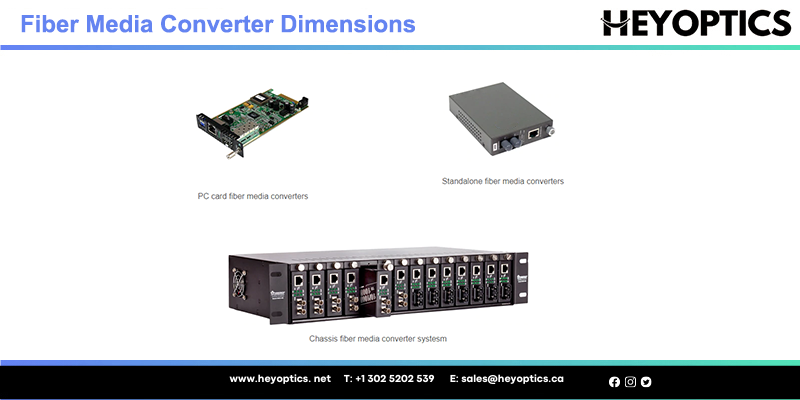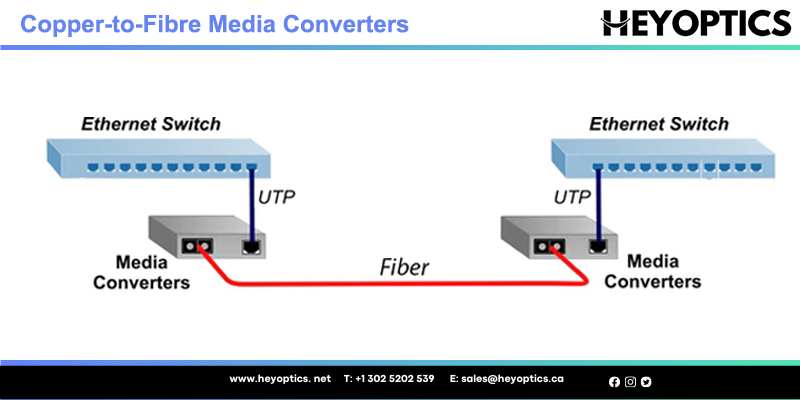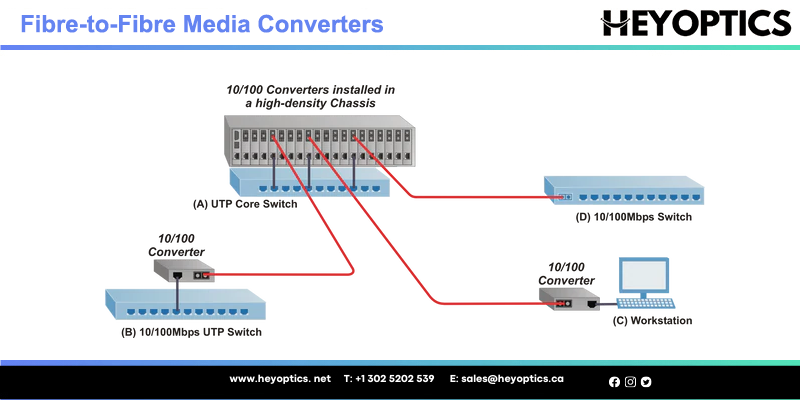How to Choose Fiber Media Converters?
In some large-scale enterprises, the network construction directly uses fiber for the transmission medium to establish the backbone network, and the internal LAN transmission medium is generally copper, how to achieve LAN connected with the fiber backbone network? This requires different ports, different Linear, and fiber between the conversion and ensures the link's quality. The emergence of a fiber-optic media converter, allows the twisted pair of electrical signals and optical signals to each other to ensure the smooth transmission of packets between the two networks while extending the network transmission distance from the copper wire from 100 meters to more than 160 kilometers (Single-mode fiber).
Fiber media converters is an indispensable network data transmission equipment, then what is an optical media converter, it has what composition, and what role does it play in the data dissemination process?
What is a Media Converter?

Fiber Media Converter Dimensions
- PC card converters
- Small standalone devices
- High port-density chassis systems

What are the basic features of a fiber media converter?
- Fully transparent to the network protocol.
- Provide ultra low delay data transmission.
- Supports Ultra wide working temperature range.
- Using ASIC chip to achieve data line-speed forwarding. The programmable ASIC centralizes many functions on a chip, which has the advantages of simple design, high reliability, and low power consumption so that the equipment can get higher performance and lower cost.
- Provide network management equipment to diagnose, upgrade, status report, abnormal Situation Report, and control function, can provide complete operation log and alarm log.
- Rack-type equipment can provide hot-swappable functions for easy maintenance and uninterrupted upgrades.
- Supports a variety of transmission distances (0~160 km).
- The Media Converter Rack adopts the dual power supply design, supports the ultra-wide power supply voltage, and realizes the power protection.
Benefits of Media Converters
Extend LAN Distance with Fibre
Maintain Investments in Existing Equipment
Protect Data from Interference
Speed Conversion
Power over Ethernet
Types of Media Converters
Copper-to-Fibre Media Converters

Fibre-to-Fibre Media Converters

PoE Media Converters
Stand-Alone vs. Chassis-Based Media Converters
Managed vs. Unmanaged Media Converters
Unmanaged fiber media converters
An unmanaged media converter allows for simple communication with one another but does not provide monitoring, fault detection, and setting up network configurations.
The unmanaged option is a great choice for newbies and if you want a plug-and-play fiber network cable installation.
There are configurations you can set through a hardware DIP switch.
Managed fiber media converters
Managed media converters cost more but offer advanced network monitoring, fault detection, remote configuration, and more functions.
They have SNMP (Simple Network Management Protocol) agent running which reports their status to the NSM (Network Management System) manager.
An SNMP managed network consist of 3 key components:
- Managed device (the media converter)
- SNMP agent, software that runs on managed devices
- Network Management Systems (NSM) software that runs on the manager (administrative computer)
Most managed media converters support all authentication, authorization, and accounting (AAA) security services used in corporate networks, including TACACS+, RADIUS, LDAP, Kerberos, NIS, and RSA.
To further protect IDs and passwords from someone ‘snooping’ on the network, managed media converters provide secure management sessions by supporting SSH, SNMPv3, Telnet, and HTTPS.
These types of features are used when managing your corporate firewalls, switches, and routers.
Commercial vs. Industrial Media Converters
They are used in a controlled environment like offices. They have commercial temperature ratings (0 ~ 40°C). They cannot be installed easily inside equipment enclosures and normally have a single power supply input.
Industrial grade fiber media converters
Are used in hot, humid, vibration-prone, electrically noisy environments. They have industrial temperature ratings (-40 to 85°C).
Industrial grade converters have rugged enclosures using Din-Rail or Panel Mounting so they can be easily installed inside equipment enclosures. They also have redundant power input.
APPLICATIONS OF FIBER MEDIA CONVERTERS
Extend the life of legacy networking equipment and wiring plants
Connect a variety of cabling types (translate between electronic and light signals)
- Coax cable
- BNC, Mini BNC
- UTP (twisted pair) Category 4, 5, and 6
- Copper RJ-45
- Multimode fiber
- Single-mode fiber
- SFP, SFP+ and XFP standard wavelength transceivers
- SFP, SFP+ and XFP CWDM transceivers
- ST, SC, LC, and MT-RJ connectors
- Dual and single fiber
Support different communication protocols
- 10M, 100M, Gigabit and 10G Ethernet
- 10G OTN (Optical Transport Network)
- T1/E1/J1
- T3/E3/DS3
- Serial RS-232, RS-422, RS-485, RS-530
- SONET (OC-3, OC-12, OC-48 and OC-96)
- Fibre Channel
- Protocol Transparent, supporting data rates up to 11.32 Gbps
Extend the range of the connections in your network by using fiber optic cabling
Fiber optic connectivity is necessary when the distance between two network devices exceeds the transmission distance of copper cabling. Copper-to-fiber conversion using media converters enables two network devices with copper ports to be connected over extended distances via fiber optic cabling.
When expanding the reach of the LAN to span multiple locations, media converters are useful in connecting multiple LANs to form one large campus area network that spans over a limited geographic area.
As premises networks are primarily copper-based, media converters can extend the reach of the LAN over single-mode fiber up to 160 kilometers with 1550 nm optics.
Conclusion
Since media converter has so many advantages, it can support advanced bridge features – including VLAN, Quality of Service prioritization, Port Access Control, and Bandwidth Control – that facilitate the deployment of new data, voice, and video to end-users. In a word, a media converter does more than convert copper to fiber and convert between different fiber types. It can also provide all these sophisticated switch capabilities in a small, cost-effective device.
These are some of the basic knowledge of optical media converter, we should have a basic understanding of fiber media converter in the application before fiber cabling to avoid any trouble.



